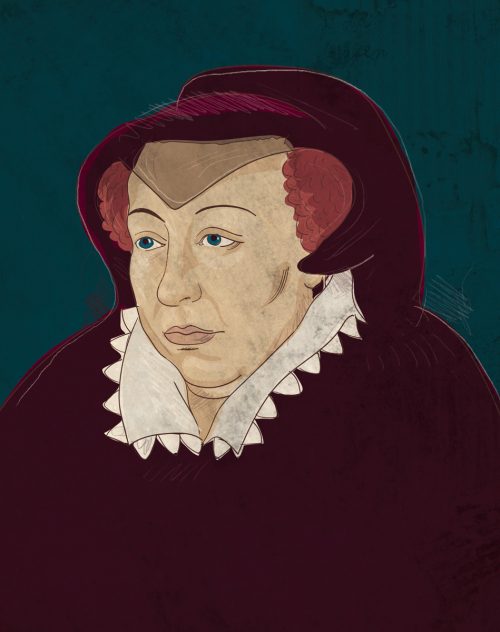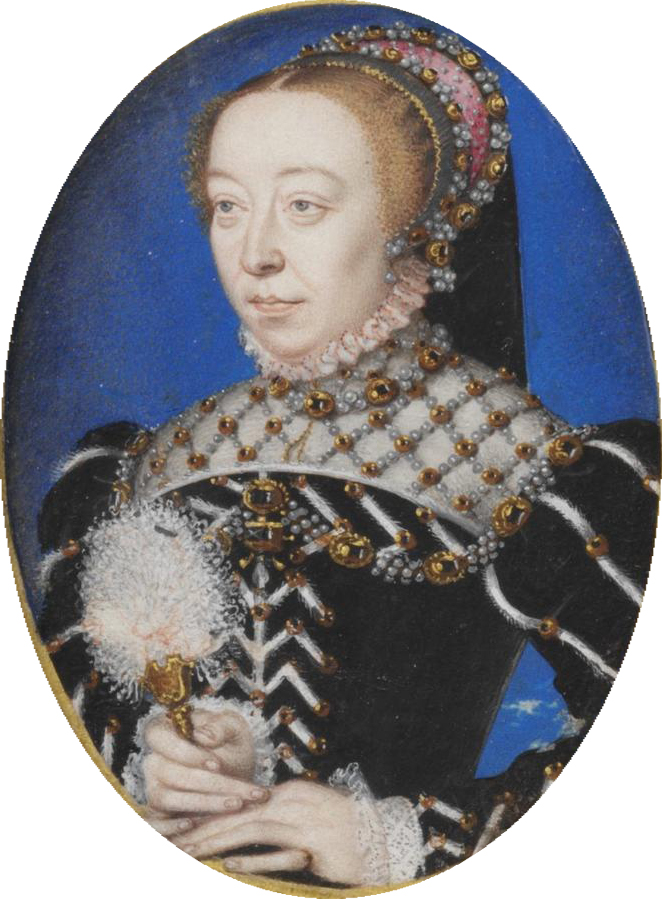What is Catherine de Medici known for introducing to the French?
On January five, 1589, when Catherine, the cracking Medici-born queen and regent of France, died of pleurisy at 69 years of historic period in Blois, just eight months before her son, Henry III, was assassinated, she was no longer the slim young maiden who had left her Florentine home to marry into Valois royalty. Although she had reached a considerable age for her epoch, Catherine's beloved of rich foods to the extent of provoking life-threatening indigestion on several occasions meant that she was overweight and had a conspicuous double chin at the time of her decease. (She also underwent ten pregnancies during her union to Henry II.) Throughout her life she notwithstanding stayed active, connected to piece of work difficult, to travel on diplomatic missions throughout the land and to ride and hunt, using the side saddle she had imported to France. Acclaimed for promoting the arts and with introducing the French to tobacco, the folding fan, handkerchiefs and ladies' drawers, Catherine also popularized the use of makeup and perfume likewise equally pilus pieces and dyes.

When Catherine arrived in Marseille to be married on October 28, 1533, her entourage included courtiers and servants, artists, musicians, dancers, embroiderers and dressmakers, hair stylists, perfume makers and firework technicians. She also brought an regular army of chefs, bakers, pastry cooks and distillers with her. Their baggage contained artichokes, lettuce, parsley and truffles likewise as forks and other fine silverware, glazed tableware and cute table decorations, unknown in France at that fourth dimension. Until so, fingers, spoons and knives had been used to scoop up food or else it was simply eaten on slices of bread.
Out of this, a fable grew over the centuries that Catherine had, well-nigh single-handedly, and so influenced French cooking that she was credited with establishing the country's distinctive national cuisine. Even the cracking chef of kings and nutrient writer, Marie Antoine Careme (1784-1833), believed that "the cooks of the second half of the 1700s came to know the gustatory modality of Italian cooking that Catherine de' Medici introduced to the French courtroom".
More recent research shows that Catherine's gastronomic impact was not then all-encompassing. At the time of her inflow in France, the court of Francis I was one of the most sophisticated in Europe. Certainly, the Italian Renaissance had an effect on its neighbour, but the French had already undergone their own Renaissance when the cultured Francis I became patron of the arts, inviting artists similar Leonardo da Vinci, Andrea del Sarto, Benvenuto Cellini, Rosso Fiorentino and other Italian painters to decorate his various palaces.

At a recent briefing, Catherine de' Medici: 500 Years of Italian Hospitality, hosted by Apicius International School of Hospitality of the Florence University of the Arts, Catherine was described, in many of the presentations, as a talented and imaginative hostess, and it was demonstrated how soon many of the recipes her cooks brought with them began to appear on French tables and take connected to remain at that place. Today, however, they are thought of as being French. In his presentation, the executive sous chef and vice managing director of the Apicius schoolhouse, Massimo Bocus, told united states that famous dishes like French onion soup originated in the Florentine carabaccia, while Béchamel was based on the salsa colla, duck à l'orange stemmed from the Tuscanpapero alla melarancia and macaroons had their roots in the spiced cookies created by Italian monks in the Center Ages, who used the unmarried halves every bit spoons. Catherine is likewise known to accept used spices not purely to mask the flavour of nutrient, as was common until so, but to heighten it. She separated spicy from sweet dishes and created a fruit sherbet or granite fad later they were served at her wedding banquet thank you to the Florentine melt Ruggieri, their inventor, who was part of her retinue.
Another presenter, Fabio Binarelli, convincingly argued that, to portray the force of the French courtroom to both its subjects and foreign powers, Catherine organised what were called magnificences or sumptuous, hugely expensive happenings that took place over several days where music, dancing, fashion, banquets and tournaments became a means of enforcing political control, especially in the interests of her young sons. Through these amusements, Catherine was also able to display her artistic inventiveness.
Examples of these pageants include efforts, in January 1564, to bolster the reign of her fourteen-twelvemonth-old son, Charles 9, when Catherine took the court on an itinerant journeying effectually French republic. The royal household was to be seen and admired as information technology traveled the country for almost two and a half years, taking with it all that was necessary to hold its spectacular festivities. At the Château de Fontainebleau, each important noble was asked to host a ball. Orchestras played music written by the composer superstars of the era. In turn, Catherine held a banquet where her courtiers dressed as shepherds and shepherdesses and, in the days that followed, at that place were jousting and Greek mythology-themed performances.
Again, in 1573, merely a year later on the St. Bartholomew Day massacre, Catherine hosted entertainments for the Polish ambassadors who had come to offering the throne of Poland to her son, Henry, so Duke of Anjou. Catherine spared no expense and staged a m brawl at the Tuileries Palace, where xvi nymphs meant to represent the 16 French provinces danced a complex choreographed ballet.
In 1581, during her son Henry 3's reign, Catherine staged the colossally costly Joyeuse magnificences. Lasting most two weeks with an allegoric sun and moon theme, they celebrated the marriage of the king'southward sister-in-law, Marguerite of Lorraine, to his favourite, Anne de Batarnay, Duke of Joyeuse. Catherine'south Ballet Comique de la Reine, performed during the celebrations, is considered the first ballet de cour, the beginning of modern ballet.
At that place tin can, therefore, exist little doubt that fifty'Italienne, as the French disparagingly called this upstart girl of Florentine merchants, left her culinary marking on her adopted homeland and she will long be remembered.
Source: https://www.theflorentine.net/2019/04/12/litalienne-catherine-de-medici/#:~:text=Even%20the%20great%20chef%20of,introduced%20to%20the%20French%20court%E2%80%9D.
0 Response to "What is Catherine de Medici known for introducing to the French?"
Post a Comment